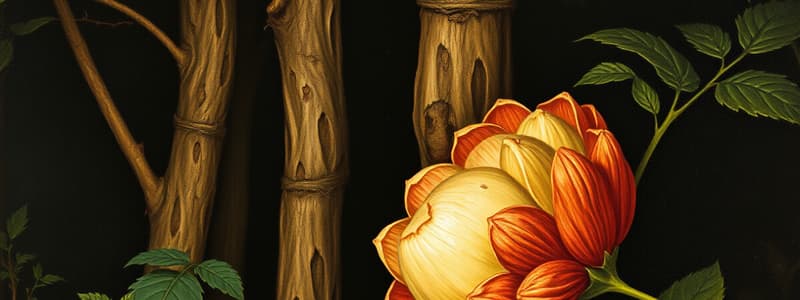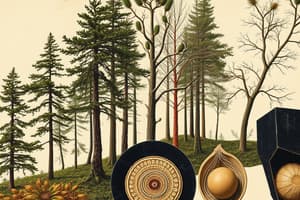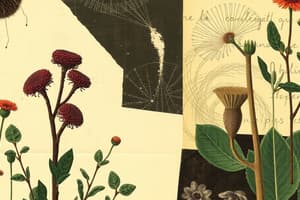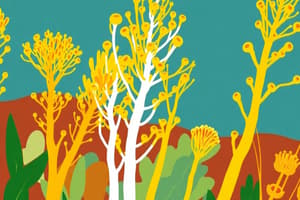Podcast
Questions and Answers
Which of the following contains multiple gymnosperm ovules?
Which of the following contains multiple gymnosperm ovules?
- Ovule cone (correct)
- Pollen grain
- Stamen
- Seed
What is found inside a pollen grain?
What is found inside a pollen grain?
the male gametophyte
What are the main components of a mature gymnosperm seed?
What are the main components of a mature gymnosperm seed?
seed coat, food supply, embryo
When you look at a pine or maple tree, the plant you see is a _____?
When you look at a pine or maple tree, the plant you see is a _____?
All seed plants _____?
All seed plants _____?
Which of these structures contains a male gametophyte?
Which of these structures contains a male gametophyte?
In pines, the female gametophyte contains _____, each of which contains a(n) _____?
In pines, the female gametophyte contains _____, each of which contains a(n) _____?
In pines, an embryo is a(n) _____?
In pines, an embryo is a(n) _____?
In pine trees, pollen grains get to the ovule via the _____?
In pine trees, pollen grains get to the ovule via the _____?
Which of these statements is true about the gametophyte tissue that surrounds the pine embryo?
Which of these statements is true about the gametophyte tissue that surrounds the pine embryo?
Of the four haploid cells produced by a pine cone's megasporocyte (megaspore mother cell), _____ survive(s)?
Of the four haploid cells produced by a pine cone's megasporocyte (megaspore mother cell), _____ survive(s)?
In the pine, microsporangia form _____ microspores by _____?
In the pine, microsporangia form _____ microspores by _____?
Gymnosperms were most abundant during the _____?
Gymnosperms were most abundant during the _____?
In gymnosperms, megaspores develop into __________?
In gymnosperms, megaspores develop into __________?
Ovules are found within structure _____?
Ovules are found within structure _____?
Which of these is unique to flowering plants?
Which of these is unique to flowering plants?
The male gametophytes of flowering plants are also referred to as _____?
The male gametophytes of flowering plants are also referred to as _____?
In flowering plants, the integuments of the ovule develop into a(n) _____?
In flowering plants, the integuments of the ovule develop into a(n) _____?
A carpel is composed of _____?
A carpel is composed of _____?
A stamen consists of _____?
A stamen consists of _____?
In angiosperms, pollination is the transfer of pollen grain to the _____ of a flower on the same plant or another plant of the same species?
In angiosperms, pollination is the transfer of pollen grain to the _____ of a flower on the same plant or another plant of the same species?
Angiosperms are different from all other plants because only they have _____?
Angiosperms are different from all other plants because only they have _____?
Which of the following parts would you expect to be most reduced in a grass flower?
Which of the following parts would you expect to be most reduced in a grass flower?
Human survival literally depends on the produce of _____?
Human survival literally depends on the produce of _____?
What are the products of meiosis in the life cycle of a seed plant?
What are the products of meiosis in the life cycle of a seed plant?
Select the correct description of the seed.
Select the correct description of the seed.
Flashcards are hidden until you start studying
Study Notes
Gymnosperms
- Ovulate cones contain multiple gymnosperm ovules.
- Pollen grains contain male gametophytes, which facilitate reproduction.
- Mature gymnosperm seeds consist of a seed coat, food supply, and embryo.
- The visible pine or maple tree is a diploid sporophyte.
- All seed plants exhibit heterosporous reproduction.
- In pines, female gametophytes contain archegonia that produce eggs.
- An embryo in pines is classified as an immature sporophyte.
- Pollination in pine trees occurs via micropyle access to ovules.
Gametophytes and Reproductive Structures
- Surrounding the pine embryo, gametophyte tissue serves as a haploid food reserve.
- Of the four haploid cells produced by a pine cone's megasporocyte, only one survives.
- In pines, microsporangia yield haploid microspores through meiosis.
- Gymnosperms were dominant during the Mesozoic era.
- Megaspores in gymnosperms develop into female gametophytes.
Angiosperms
- Double fertilization is unique to flowering plants.
- Male gametophytes in flowering plants are known as pollen grains.
- Integuments of the ovule in flowering plants develop into is a seed coat.
- Carpels consist of stigma, style, and ovary.
- Stamens comprise an anther and filament.
- In angiosperms, pollination is the transfer of pollen grains to the stigma.
- Angiosperms possess flowers, a distinguishing characteristic of this group.
Other Key Facts
- Grasses are wind-pollinated and often have reduced petal structures.
- Human survival heavily relies on angiosperm produce.
- The products of meiosis in seed plants are megaspores and microspores.
- Seeds include genetic contributions from three distinct generations of plants.
Studying That Suits You
Use AI to generate personalized quizzes and flashcards to suit your learning preferences.




